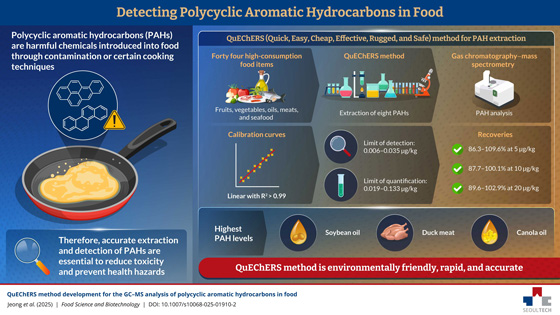A new method for detecting carcinogens in cooking oils and meat at low cost and with high accuracy has been developed

With growing health consciousness, more people are choosing nutritious foods such as fruits and vegetables, but these foods can contain
QuEChERS method development for the GC–MS analysis of polycyclic aromatic hydrocarbons in food | Food Science and Biotechnology
https://link.springer.com/article/10.1007/s10068-025-01910-2
Scientists Uncover Cancer-Causing Chemicals in Common Foods
https://scitechdaily.com/scientists-uncover-cancer-causing-chemicals-in-common-foods/
What are polycyclic aromatic hydrocarbons (PAHs)?
Polycyclic aromatic hydrocarbons (PAHs) are hydrophobic organic compounds with multiple fused aromatic rings. They can be introduced into plant foods such as fruits and vegetables through atmospheric deposition from vehicle and industrial exhaust fumes, absorption from contaminated water and soil, and are most commonly produced when animal foods such as meat and seafood are exposed to extremely high temperatures, such as direct flame or smoke.
Foods known to have relatively high levels of PAHs include:
・Smoked or grilled meats and seafood (smoked salmon, bacon, barbecued chicken, browned beef, etc.)
Roasted or burnt plant foods (roasted coffee beans, dark roasted nuts, burnt vegetables, overcooked toast, etc.)
・High-temperature processed oils and fats (recycled frying oil, highly refined vegetable oil, etc.)
・Heat-processed grain products (roasted grains, malted products, baked snacks, etc.)
- Agricultural products exposed to environmental pollution (leafy vegetables, root vegetables, fruits, etc. grown along roads or near industrial areas)
・Smoked tea leaves and herbs (black tea, green tea, certain herbal teas, etc.)
Certain PAHs are known carcinogens, and their detection in such a wide variety of foods is a major public health concern that requires monitoring and action throughout the food supply chain.
High-precision detection using QuEChERS method
Common extraction methods for polycyclic aromatic hydrocarbons in food include solid-phase extraction , liquid-liquid extraction , and accelerated solvent extraction . However, while these are cost-effective, they have drawbacks such as slow processing speed, a heavy workload, and a high environmental impact.
A research team led by Professor Joon-Goo Lee of the Department of Food Science and Biotechnology at Seoul National University of Science and Technology conducted a study to quantify the following eight PAHs in food using the QuEChERS method , which stands for Quick, Easy, Cheap, Effective, Rugged, and Safe.
・Benz[a]anthracene
・Chrisen
Benzo[b]fluoranthene
・Benzo[k]fluoranthene
・Benzo[a]pyrene
Indeno[1,2,3-cd]pyrene
・Dibenz[a,h]anthracene
・Benzo[g,h,i]perylene)
Extraction of PAHs from samples with acetonitrile, purification with adsorbents, and analysis by gas chromatography-mass spectrometry (GC-MS) revealed detection limits ranging from 0.006 to 0.035 µg/kg and quantitation limits ranging from 0.019 to 0.133 µg/kg. Of particular note were the high recoveries of 86.3 to 109.6% at 5 µg/kg, 87.7 to 100.1% at 10 µg/kg, and 89.6 to 102.9% at 20 µg/kg. Precision was within the range of 0.4 to 6.9% for all foods.

Compared to previous methods, testing time has been reduced from several hours to a day to 30 minutes to an hour, and the amount of solvent required has been reduced from 200ml to 500ml to 10ml to 15ml, resulting in a corresponding reduction in the amount of waste liquid. This is expected to result in cost reductions in labor costs, solvent purchasing costs, and waste disposal costs.
'This method not only simplifies the analytical process, but also has the advantage of being extremely efficient compared to conventional methods, making it applicable to a wide range of foods,' said Professor Lee. 'It can contribute to improving public health by providing safer food, and it can also reduce the use and emissions of harmful chemicals involved in conventional testing.'
Related Posts:
in Science, Posted by darkhorse_logmk







